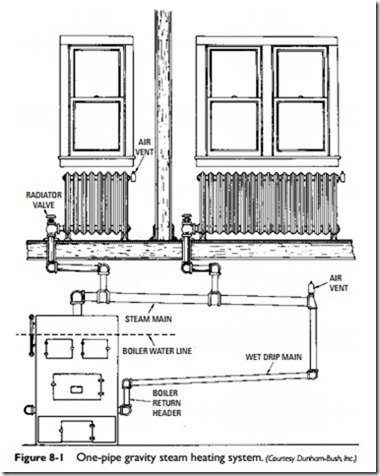Gravity Steam Heating Systems
Gravity systems are generally limited to residences and small buildings where the heat-emitting units can be located at least 24 inches above the water-level line of the steam boiler.
A gravity steam heating system is characterized by the fact that the condensate is returned to the boiler from the heat-emitting units by means of gravity rather than mechanical means. Both one- and two-pipe installations are used, with the former being the oldest and most commonly used for a number of years (Figures 8-1 and 8-2). These one-pipe steam systems were designed to move the steam from the boiler to the heat-emitting units at no greater than 4 oz of steam pressure.
Gravity steam heating systems are the cheapest and easiest to install because they are adaptable to most types of structures, but they do have a number of inherent disadvantages. The principal disadvantages of gravity steam heating systems are:
1. The return lines in one-pipe gravity systems must be large enough to overcome the resistance offered by the steam flow- ing up from the boiler in the opposite direction.
2. There is the possibility of water hammer developing in one- pipe systems because the steam and condensate must flow in opposite directions in the same pipe.
3. Air valves (which are required) sometimes malfunction by either spurting water or failing to open. If the latter situation is the case, excess heat will build up in the system.
4. Automatic control of the steam flow from the boiler results in room-temperature fluctuations.
5. Comfortable room temperatures are possible by manually regulating the valves on individual heat-emitting units, but this results in some inconvenience.
6. In two-pipe gravity systems, the condensate return from each heat-emitting unit must be separately connected to a wet return or water sealed. This is expensive.
The principal reason for the development of the two-pipe gravity system is to create a means of overcoming the resistance offered by the steam flow to the condensate returning to the boiler.
